Fujifilm X-T1 Review
Fujifilm X-T1 Introduction
The Fuji X-T1 is the most advanced Fuji mirrorless yet. It is built around a revised 16 megapixels X-Trans CMOS II sensor with built-in Phase-Detect AF and paired with the latest generation EXR II processors. This combo delivers full-resolution images from ISO 100 to 51200, a first among mirrorless cameras. It can sustain frame-rates of 8 FPS for up to 47 JPEG or 24 RAW files.
The highly-mechanical design of the X-T1 blends analog and digital controls in an elegant and sturdy metal body. This mirrorless is the first such Fuji to be weather-sealed and freeproof down to -10C. Its dedicated ISO, EC and Shutter-Speed dials, plus dual control-dials, give direct access to all essential photography controls.
Fuji put a great deal of emphasis on the new 2.4 megapixels OLED EVF with huge 0.77X magnification and 100% coverage. It boasts a class-leading lag time of ½ms and image-centric layout which automatically rotates and activates thanks to an Eye-Start sensor.
The unique 16 MP X-Trans CMOS II sensor with built-in Phase-Detect AF has a 1.5X crop-factor and 3:2 aspect-ratio. Like the original X-Trans sensor, the one in the X-T1 forgoes an anti-alias filter and is not prone to Moire thanks to its unique color-filter.
The X-T1 uses Fuji's own XF lens mount which has a very short flange distance. This makes it easier to design high-quality lenses and lens-mount adaptors, including one made by Fuji for the Leica M-mount. Fuji launched a total of 12 lenses so far, mostly bright prime lenses, rather than the usual zooms, reinforcing the X-T1 as a high-end offering with a small footprint. This is crucial for SLDs since they must provide a clear advantage over DSLRs which have an iron-grip on the high-end digital camera market.
Note that no X-mount lens is currently weather-sealed, making the weather-sealing of the X-T1 more theoretical than practical. Fuji has announced plans to change with with a set of professional constant-aperture zooms but there are no availability dates yet.
This digital camera review analyses the usability, performance and image quality of the Fuji X-T1.
Fuji X-T1 Features
Sensor
- 16 Megapixels CMOS sensor
- X-Trans 6x6 Color-Filter Array
- No Anti-Alias filter
- 1.5X Crop factor (APS-C)
- 3:2 Aspect ratio
- Phase-Detect AF
- Fuji XF lens mount
- Dust-Reduction
Exposure
- ISO 200 to 6400 sensitivity range, 1/3 EV steps
- ISO 100, 12800 - 51200 expansion, JPEG only
- Auto ISO, Selectable maximum from 400 to 6400
- ISO Bracketing, 3 frames, 1/3-1 EV steps
- 1/4000-30s Shutter-speeds, 1/3 EV steps
- Bulb exposure, maximum 1 hour
- PASM Exposure modes
- Multi-Segment, Spot and Average metering
- Exposure-Compensation, ±3, 1/3 EV increments
- AEB, 3 frames, 1/3-1 EV increments
- 100%, 200% or 400% Dynamic-Range
- Flash-Compensation, ±2, 1/3 EV steps
- Auto, Forced, Slow-Sync, Rear-Sync, Wireless and Off Flash modes
Image Parameters
- Automatic, 7 presetsSunny, Shade, 3 Fluorescents, Incandescent, Underwater, Kelvin and Custom WB
- WB fine-tuning along 2 axis in 19 steps
- WB Bracking, 3 frames, 3 step sizes
- Film Simulation: Provia, Velvia, Astia, Pro Negative Hi, Pro Negative Standard, B&W plus 3 optional filters, Sepia
- Film Simulation Bracketing, 3 frames
- Adjustable Color, Sharpness, Highlight Tone, Shadow Tone and Noise reduction 5 steps each
- Optional Lens Modulation Optimizer
- Optional Long-Shutter noise reduction
Focus
- Single-shot or Continuous autofocus
- Manual-focus (MF), Electronic Magnification
- Automatic or Manual focus-point selection
- Hybrid 49-point AF system
- Optional Digital Split Image
- Optional Focus Peaking
- Optional MF-Assist view
- Optional AF-Assist lamp
- Fly-By-Wire focus-ring on most lenses
Drive
- 8 FPS Continuous Drive
- 47 JPEG or 24 RAW Buffer
- Motion Panorama, Normal or Wide
- Interval Timer, 1s-24h interval, 1-999 frames, 0m-24h delay
- Multiple-Exposure, 2 frames
- Self-timer, 2s or 10s
Video
- 1920x1080 @ 60 FPS Video
- 1280x720 @ 60 FPS Video
- MPEG-4 codec
- Stereo sound
- 4 Audio input levels
- Mini-Jack audio input
Display & Viewfinder
- 0.5" EVF, 2.4 Megapixels, 0.77X Magnification
- 100% Coverage
- Eye-Start sensor
- 3" Tilting LCD, 1 Megapixel
- Digital Level, 1-axis
- Depth-Of-Field Preview
- Optional Live-Histogram
- Optional Framing-Guides, 3 types
Output Processing
- 3:2 Native aspect ratio
- 16:9 and 1:1 cropped aspect ratios
- 16, 8 and 4 megapixels modes
- JPEG, RAW, RAW+JPEG capture
- 2 JPEG Compression levels
Misc
- Dual control-dials
- ISO sensitivity dial
- Exposure-Compensation dial
- Shutter-speed dial, full-stops only
- Aperture ring on lenses
- 6 Customizable Buttons
- Customizable AE-L button
- Standard Hot-Shoe & Sync-Port
- Wired-Remote connector
- HDMI (1080i) output
- USB 2.0 connectivity
- Lithium-Ion battery
- SDXC memory
- UHS-II Support
- Built-in WiFi
Fujifilm X-T1 Usability - How easy is it to use?
While the original X-Pro1 and high-end models which followed it, such as the recently reviewed Fuji X-E2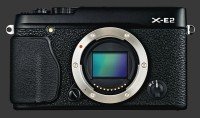
Fujifilm X-E2, were markedly retro, the X-T1 features an all-new hybrid design which blends the dual control-dials of modern digital cameras with analog dials for all exposure parameters with aperture being usually control via a ring around the lens. This requires some explanations which we details right on this page, along with compromises taken in its execution.
The Fuji X-T1 is build upon a solid metal frame with rubber coating wrapping from the front to the back on the grip-side. The entire camera feels solid with a confidence-inspiring weight. The weak-point is that Fuji included a tiling LCD. The hinge is remarkably solid yet remains the only part which shows some flex. Given its built-in WiFi capability, there is little reason to have a titling display. Incidently, this LCD is one of only six such weather-sealed displays. This is a compromise Fuji choose which seems out-of-place on a high-end offering.
This mirrorless camera is smaller than it appears given its large display and high number of external controls. While busy, the Fuji X-T1 is not cramped. It is smaller than nearly every APS-C DSLR but mostly in depth. This mostly means a comparatively shallow grip. At least there is one and it is sufficient to hold the camera securely with current X-mount lenses. A rubberized protrusion at the greatly helps keep the camera steady.
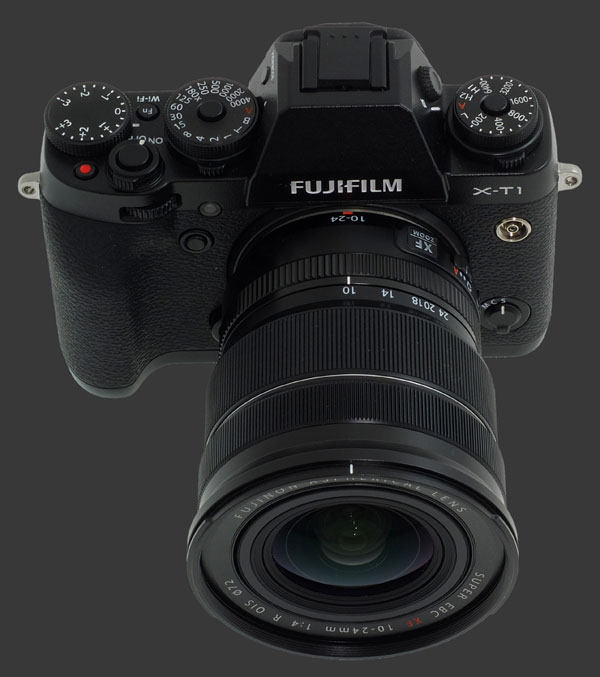
The front of the X-T1 shows a few items around the lens mount. Starting clockwise from the upper-right, there is a standard Sync-Port to connect studio lighting. There is a 3-way Focus-Mode switch a the lower-right. This one selects between Manual, Continuous and Single focus. At the lower-left of the mount is the Lens-Release.
Higher up there is an unmarked customizable button with the front control-dial and AF-assist lamp above it. The front control-dial is small and, most-inconveniently, too flush the the camera-surface. As we will see, this issue plagues most other buttons and make the X-T1 extremely difficult to use with gloves on.
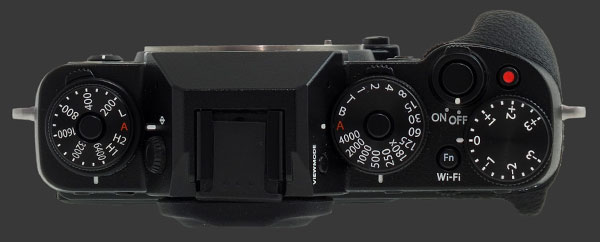
The top-plate is crowded with analog dials. The 3 show exposure-parameters quite clearly: ISO, Shutter-Speed and Exposure-Compensation. Aperture can also usually be seen from the top too because it is marked on all Fujinon prime lenses. This makes the exposure settings quite visual with a few caveats. First, the ISO dial is marked in 1/3 stops only has two High positions. Since there are 3 such sensitivities, the ones selected by the dial are determined by the Setup menu. The Shutter-Speed dial is marked in full-stops until 1s. Slower shutter-speeds and 1/3 increments are set by the control-dials and hence are not visible from the top.
The ISO and Shutter-Speed dials have an automatic position marked A. Lenses also have an A position to set aperture automatically. On prime lenses, this is a distinct position of the aperture-ring. On zooms, it is a switch. The Exposure-Mode is implicit by the positions of all these dials. This is simple yet crucial to understand. Any accidental movement of these dials causes the mode to change which is why Fuji locked the ISO and Shutter-Speed dials. Unfortunately, the aperture-rings on all lenses so far have detents which are way to soft.
Some photographers complain that the locks slow them down, while others find them essential. There is no lock on the EC dial which is another one which can accidentally lead to surprising output. Of all these controls, lens aperture-rings are the most problematic, so photographers must constantly keep an eye on the aperture status in the EVF or LCD.
Tucked between the Shutter-Speed and EC dials, and we really mean tucked, there is a rather small and hard-to-reach customizable buttons. Luckily, the X-T1 has a total of 6 user-defined controls. Ahead of this one, at the inner-edge of the grip is a standard two-stage shutter-release surrounded by a rotating power-switch. This flat shutter-release has a moderate amount of travel to the halfway point. The full-press is just a hair below.
There are two more, barely-visible, controls on the top: The Drive-Mode dial is located just below the ISO one. Plus, the Metering dial is located below the Shutter-Speed one. Both dials have soft detents and use small tabs to turn them. As with the majority of controls, gloves make these hard to use.
The last item to see on top is the standard hot-shoe that sits on top of the EVF housing. On one side of the housing there is a rotating diopter control. On the other, there is a button which cycles between Eye-Sensor modes: EVF, LCD or Automatic.
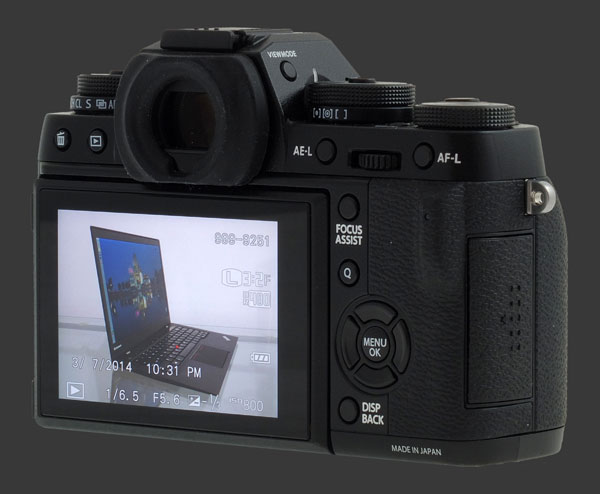
The sides of the camera each have a hard plastic door. On the left, there are HDMI and USB connectors plus a mini-jack. The mini-jack serves as stereo audio input or wired remote. On the right, there is memory card slot which supports SDXC cards, including UHS-II which deliver speeds up to 312MB/s. The compartment does not appear to have any sealing which is odd for a weather-sealed camera.
The Fuji X-T1 features a high number of controls on its back which is dominated by a wide 3" tilting LCD with one megapixel of resolution. Just above the LCD, there is a 0.5" EVF with 2.4 megapixels with a class-leading 0.77X magnification. The LCD is sharp with fluid motion and good visibility. The EVF however is a marvel to look at. It is extremely sharp and refreshed with an imperceptible lag. Fuji claims ½ milliseconds.
The view in the EVF is amazingly clear. Fuji chose an uncrowded layout places very little information on the time, providing a more DSLR-like experience. The Digital-Level, Live-Histogram and Focus Area overlay the image, while other information surrounds it. The layout even rotates to be more readable in portrait orientation. The LCD though does none of this and provides a nice but traditional view.
In low-light, the EVF maintains a bright image while getting more grainy. A lag is perceptible in moderately dark locations which is to be expected but better than usual. Clearly, this EVF further closes the gap between optical and electronic viewfinders while provided an impressive number of useful MF-assist views: Magnified View, Detailed View, Focus Peaking and Digital Split-Image.
Where both displays falter is that they are only Exposure-Priority in Manual exposure. It's not understandable why one would knowingly show a misleading preview. The histogram follows the display so tis only accurate with Manual exposure.
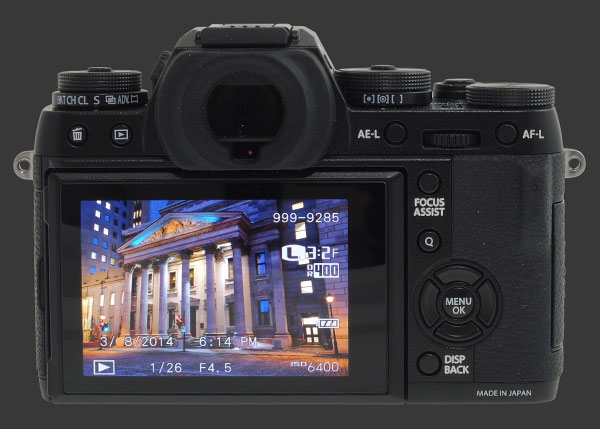
The back of the camera is plastered with buttons. Directly to the left of the EVF, there is a Delete and Playback button which work exactly as expected. Across from the viewfinder, there is a customizable AE-L button. It can hold or toggle exposure-lock. The camera's rear control-dial is next to it and almost flush with the surface which makes it difficult to turn, particularly with gloves on. Further right, there is an AF-L button which locks focus only or both focus and exposure.
Below the rear control-dial, there is a Focus-Assist button which toggles focus-area magnification. A Q button is found further down. That one brings up an iconic menu which gives quick access to 16 camera settings: Custom Setting, AF-Point, Dynamic-Range, WB, Noise-Reduction, Image Size, Image Quality, Film Simulation, Highlight Tone, Shadow Tone, Color, Sharpness, Self-Timer, Face-Detect, Flash Mode and LCD Brightness.
There is a 4-way controller with central OK button under the thumb-rest. The middle button activates the Menu system while each directional one can be assigned an individual function: Bracket, Macro, DOF Preview, Auto ISO, Self-Timer, Image-Size, Image-Quality, Dynamic-Range, Film Simulation, White-Balance, AF Mode, Focus Area, Custom Settings, Face-Detect, RAW, Aperture Settings or WiFi.
The last button on the back is the Disp/Back button which is used to cycle over display modes or cancel actions. Fuji provides 3 set display modes plus a customizable one for the LCD. With the EVF on, Disp toggles between normal and full view.
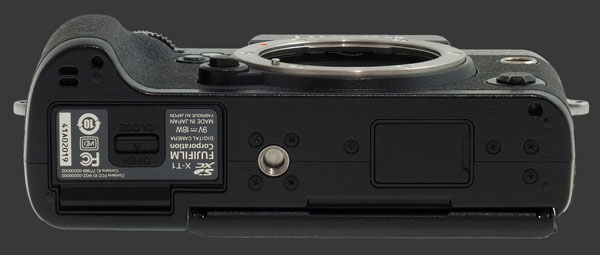
The bottom of the Fuji X-T1 has a metal tripod mount which is neither in-line with the optical axis nor with the center of gravity of the camera. There is also a battery-compartment door and a battery-grip connector there.
The design of the Fuji X-T1 is well-intended yet poorly executed. Buttons and dials are all in the right place while giving access to all major camera functions. The main issue with the X-T1 is that control-dials and most buttons do not protrude enough which makes many of them seem unresponsive. The dials have rather soft detents and are prone to accidental changes, with exception for 2 locked ones on the top-plate. Fuji X-mount lenses all have very soft aperture-rings which make it easy to inadvertently change the aperture.
Over the course of the review, many images ended up being taken at the wrong settings. Often, consequences were minor. Other times, moments were missed. One must get accustomed to checking dials and settings often with the X-T1. Given this is the only freezeproof Fuji mirrorless, it is disappointing that the usability with gloves is truly limited.
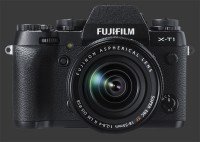 |
Please Support Neocamera
All information on Neocamera is provided free of charge yet running this website is a huge endeavor. Purchases made via affiliate links found throughout the site help keep it running and up-to-date. There is no additional cost to you, so please consider buying via these links to our affilates:
Thank you for your support!
Fujifilm X-T1 Highlights

Sensor-Size: 24 x 16mm

Actual size when viewed at 100 DPI
| 16 Megapixels Mirrorless | ISO 100-51200 |
| Fujifilm X Mount 1.5X FLM | Shutter 1/4000-30s |
| 0.50" Built-in EVF 2.4 Megapixels (0.77X) | Full manual controls, including Manual Focus |
| Automatic Eye-Start sensor | Custom white-balance with 2 axis fine-tuning |
| 1 Axis Digital Level | Spot-Metering |
| Weatherproof down to -10C | Hot-Shoe |
| Built-in Dust Reduction | Stereo audio input |
| 8 FPS Drive, 47 Images | Lithium-Ion Battery |
| 1920x1080 @ 60 FPS Video Recording | Secure Digital Extended Capacity |
| 3" LCD 1 Megapixels |
Updates
2025.11.13

Best Gifts for Photographers in 2025 by Budget
The annual Neocamera Photography Gift Guide updated to 2025. Find great gifts for photographers with any price budget.
2025.07.07

Stellar Photo Recovery Review
Review of Stellar Photo Recovery V12. This Windows and MacOS software can recover photos and videos in a huge number of formats from memory cards, USB drives, SSDs and HHDs.
2025.05.14

Huion Kamvas 13 Gen 3 Review
In-Depth review of the Huion Kamvas 13 Gen 3 Pen Display Tablet for photographers and graphic artists.
2025.01.18

Fujifilm GFX 2025 Lens Roundup
Lens Review roundup of Fujifilm GFX Medium-Format lenses. Quality, performance and handling of the GF20-35mm F/4R WR, GF30mm F/3.5 Tilt-Shift and the GF55mm F/1.7.
2024.11.18

Best 2024 Photography Gifts for Every Budget
Great gifts for photographers and photo enthusiasts selected for every budget among the best products of 2024.
2024.08.07

Eye Protection Tips for Professional Photographers
The four main considerations for professional photographers regarding eyewear.
2024.07.14

Fujifilm X100VI Review
Flagship fixed-lens compact digital camera with a 40 MP sensor and Image-Stabilization, a first for the series. Retro design featuring dual control-dials, plus direct ISO, Shutter-Speed and EC dials. Its hybrid viewfinder can switch between EVF and OVF mode.
2024.05.09

Fujifilm GFX100 II Review
Flagship 102 Megapixels Medium-Format Mirrorless Digital Camera with 8-Stop 5-Axis IBIS, 8 FPS Drive, 8K Video and 400 MP Super-Resolution capture in a weatherproof and freezeproof body with dual control-dials and dual memory-card slots.
2024.04.03

Fujifilm X-T5 Review
Newest Fujifilm flagship boasting a 40 MP APS-C sensor, 5-axis IBIS with 7-stop efficiency, 15 FPS continuous drive, 6.2K Video capture, dual control-dials and dual SDXC UHS-II slots in a sturdy weatherproof and freezeproof body.
2023.11.20

Best Digital Cameras of 2023
Find out which are the Best Digital Cameras of 2023. All the new Mirrorless Digital Cameras from entry-level to high-end professional.
2023.07.10

Fujifilm X-H2 Review
40 Megapixels APS-C Hybrid Mirrorless Digital Camera with 7-stop IBIS. Fastest shutter ever and 8K video capture. Large builtin EVF with 0.8X magnification and 5.8 MP, plus an Eye-Start Sensor. Packed with features and large number of controls in a weatherproof and freezeproof body.
2023.05.07

Sony FE 20-70mm F/4G Review
Review of the unique Sony FE 20-70mm F/4G lens. The optical zoom of this lens spans ultra-wide-angle and medium focal-length coverage, making it one of the most versatile Full-Frame lenses on the market.












